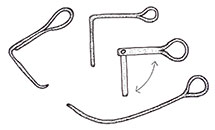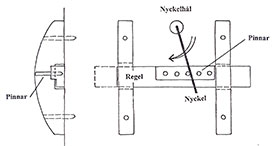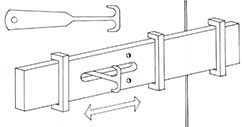The discovery of S-bit keys is concentrated in grave fields in and around Värnamo in the province of Småland. All such slide keys are made of iron. The Viking-Era smiths had a long tradition behind them: malleable iron has been manufactured in blast furnaces in Sweden for over 2,000 years.
How is it that so many keys of this particular type are found in such a small area of Småland? There is much to indicate that the keys were made in a single smithy in the Viking-Era marketplace that later became the town of Värnamo. The keys were likely forged at different times by different smiths, which would explain discrepancies in the smithwork. They are all of different lengths, one has a twisted shaft, one has a small ball on the shaft, and there are differences in the S-shape of the bit.
The keys may have spread out to the different sites as trading goods or gifts, or carried with women who left the community to marry.
 |
| Key for a push key lock from Gudhjem on the island of Bornholm. Sketch by the author. |
Other types of push keys
The most common push key locks are still found on the doors of old sheds in the country. Positioned on the inside of the door or wall, they consist of a simple wooden bolt that can be slid left and right with an angular key of iron or wood. This style of lock evolved into its current form in the Viking Era, and has many local variations.
 |
| Push keys. Sketch by the author. |
 |
| Push key with lock. Sketch by the author. |
Other wooden push keys, sometimes called Celtic locks, work on the same principle. The keys are designed with a bit that looks like an anchor.
 |
| Celtic push key lock. Sketch by the author. |